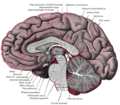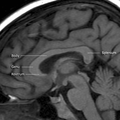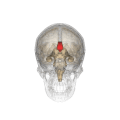Corpus callosum: Difference between revisions
CSV import |
CSV import |
||
| Line 22: | Line 22: | ||
{{stub}} | {{stub}} | ||
{{dictionary-stub1}} | {{dictionary-stub1}} | ||
<gallery> | |||
File:Gray733.png|Corpus callosum | |||
File:Gray720.png|Corpus callosum | |||
File:Corpuis_callosum.png|Corpus callosum | |||
File:Corpus_callosum.gif|Corpus callosum | |||
File:Fiber_tracts_from_six_segments_of_the_corpus_callosum.gif|Corpus callosum | |||
File:EEG_cap.jpg|Corpus callosum | |||
File:Slide1oo.JPG|Corpus callosum | |||
File:26638.medium-emphasizing-corpus-callosum.png|Corpus callosum | |||
File:Dti-tractography-normal-corpus-callosum.ogv|Corpus callosum | |||
File:Corpus_callosum.png|Corpus callosum | |||
</gallery> | |||
Latest revision as of 12:25, 18 February 2025
Corpus Callosum is a large, C-shaped nerve fiber bundle found beneath the cerebral cortex in the brain. It spans the longitudinal fissure, connecting the left and right cerebral hemispheres, enabling communication between them. It is the largest white matter structure in the brain, consisting of 200–250 million contralateral axonal projections.
Structure[edit]
The corpus callosum is located beneath the cerebral cortex. It is made up of white matter, which is largely composed of glial cells and myelinated axons. The corpus callosum is divided into four parts: the rostrum, the genu, the body (or trunk), and the splenium.
Function[edit]
The primary function of the corpus callosum is to integrate motor, sensory, and cognitive performances between the cerebral cortex on one side of the brain to the same region on the other side. This communication is essential for many functions, including eye movement, maintaining the balance of arousal and attention, tactile localization, and sensory perception.
Clinical significance[edit]
Damage to the corpus callosum can lead to a variety of neurological disorders, including split-brain, alien hand syndrome, and corpus callosum agenesis.
See also[edit]
References[edit]
<references />












